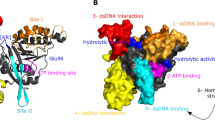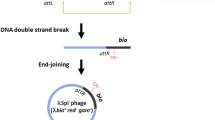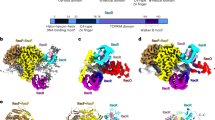Abstract
It is unknown whether the ssDNA-binding-protein (SSB) possesses the ability to catalyze DNA recombination. We investigated the recombination function of SSB and the recombination kinetics of Escherichia coli using a new transformation method with a modified double-layered plate. We found that SSB catalysed intermolecular recombination in vitro. Its intermolecular recombination rate versus substrate concentration or homologous sequence length fitted the Hill equation, and while the plasmid intramolecular recombination rate versus substrate concentration fitted a positively linear correlation, the dominant intermolecular recombination was a non-homologous recombination in vivo, similar to RecA. However, ssb-dependent recombination occurred later and at a lower recombination rate than the recA-dependent, probably because ssb expression was about two-fold lower than recA during the E. coli earlier growth stage. The affinity to substrate and the recombination efficiency of SSB was lower than RecA, whereas SSB enhanced the catalytic efficiency of RecA. Knocking out both recA and ssb led to loss of recombination. Our results confirmed that as SSB has the recombination function itself as an allosteric enzyme, recA-independent recombination in E. coli should be ssb-dependent. ssb-dependent recombination may be the third DNA double-strand break repair pathway, in addition to recA-dependent recombination and non-homologous end joining.
摘要
单链DNA连接蛋白(SSB)是否具有催化DNA重组的功能尚未见报道。我 们研究了大肠杆菌的SSB 的重组功能, 并用修改的双层平板法研究了大肠杆菌的重 组动力学。我们发现, SSB 能够在体外催化分子间的重组。大肠杆菌 recA 突变株中, 分子间重组速率与底物浓度的关系、或与同源序列长度的关系, 符合 Hill 方程; 质 粒分子内重组的速率与底物浓度呈正相关, 均与 ssb 突变株相同。然而, recA 突变 株发生重组的时间比 ssb 突变株推迟, 且重组速率、对底物的亲和力和重组效率, 均比 ssb 突变株低。同时敲除recA 和 ssb, 大肠杆菌完全失去重组功能。另外还发 现, 在大肠杆菌 recA 突变株、ssb 突变株或非突变株中, 绝大多数重组都是非同源 重组。在大肠杆菌生长的早期, ssb 的表达量比 recA 约低2 倍。结果表明, SSB 能 够独立催化 DNA 重组, 是双链DNA断裂的同源重组修复和非同源重组末端连接修 复二种途径之外的第三种重组修复途径, 即 ssb 依赖的重组修复途径。






Similar content being viewed by others
References
Michel B, Grompone G, Flore‘s MJ et al (2004) Multiple pathways process stalled replication forks. Proc Natl Acad Sci USA 101:12783–12788
Rocha EPC, Cornet E, Michel B (2005) Comparative and evolutionary analysis of the bacterial homologous recombination systems. PLoS Genet 1:e15
Jasin M, Schimmel P (1984) Deletion of an essential gene in Escherichia coli by site-specific recombination with linear DNA fragments. J Bacteriol 159:783–786
Zhang Y, Muyrers JP, Testa G et al (2000) DNA cloning by homologous recombination in Escherichia coli. Nat Biotechnol 18:1314–1317
Sharan SK, Thomason LC, Kuznetsov SG et al (2009) Recombineering: a homologous recombination-based method of genetic engineering. Nat Protoc 4:206–223
Bell JC, Plank JL, Dombrowski CC et al (2012) Direct imaging of RecA nucleation and growth on single molecules of SSB-coated ssDNA. Nature 491:274–278
Chai R, Qiu C, Liu D et al (2013) β-Glucan synthase gene overexpression and β-glucans overproduction in Pleurotus ostreatus using promoter swapping. PLoS ONE 8:e61693
Slade D, Radman M (2011) Oxidative stress resistance in Deinococcus radiodurans. Microbiol Mol Biol Rev 75:133–191
Dillingham MS, Kowalczykowski SC (2008) RecBCD enzyme and the repair of double-stranded DNA breaks. Microbiol Mol Biol Rev 72:642–671
Smith GR (2012) How RecBCD enzyme and Chi promote DNA break repair and recombination: a molecular biologist’s view. Microbiol Mol Biol Rev 76:217–228
Handa N, Morimatsu K, Lovett ST et al (2009) Reconstitution of initial steps of dsDNA break repair by the RecF pathway of E. coli. Genes Dev 23:1234–1245
Kowalczykowski SC, Dixon DA, Eggleston AK et al (1994) Biochemistry of homologous recombination in Escherichia coli. Microbiol Rev 58:401–465
Forget AL, Kowalczykowski SC (2012) Single-molecule imaging of DNA pairing by RecA reveals a three-dimensional homology search. Nature 482:423–427
Howard-Flanders P, Theriot L (1966) Mutants of Escherichia coli K-12 defective in DNA repair and in genetic recombination. Genetics 53:1137–1150
Fishel RA, James AA, Kolodner R (1981) recA-independent general genetic recombination of plasmids. Nature 294:184–186
James AA, Morrison PT, Kolodner R (1982) Genetic recombination of bacterial plasmid DNA. Analysis of the effect of recombination-deficient mutations on plasmid recombination. J Mol Biol 160:411–430
Cohen A, Laban A (1983) Plasmidic recombination in Escherichia coli K12: the role of the recF gene function. Mol Gen Genet 189:471–474
Kolodner R, Fishel RA, Howard H (1985) Genetic recombination of bacterial plasmid DNA: effect of RecF pathway mutations on plasmid recombination in Escherichia coli. J Bacteriol 163:1060–1066
Fu H, Le S, Chen H, Muniyappa K et al (2013) Force and ATP hydrolysis dependent regulation of RecA nucleoprotein filament by single-stranded DNA binding protein. Nucleic Acids Res 41:924–932
Ragunathan K, Liu C, Ha T (2012) RecA filament sliding on DNA facilitates homology search. Elife 1:e00067
Doherty MJ, Morrison PT, Kolodner R (1983) Genetic recombination of bacterial plasmid DNA. Physical and genetic analysis of the products of plasmid recombination in Escherichia coli. J Mol Biol 167:539–560
Bubeck P, Winkler M, Bautsch W (1993) Rapid cloning by homologous recombination in vivo. Nucleic Acids Res 21:3601–3602
Oliner JD, Kinzler KW, Vogelstein B (1993) In vivo cloning of PCR products in E.coli. Nucleic Acids Res 215:192–5197
Martin A, Toselli E, Rosier MF et al (1995) Rapid and high efficiency site-directed mutagenesis by improvement of the homologous recombination technique. Nucleic Acids Res 23:1642–1643
Conley EC, Saunders JR (1984) Recombination-dependent recircularization of linearized pBR322 plasmid DNA following transformation of Escherichia coli. Mol Gen Genet 194:211–218
Abastado JP, Darche S, Godeau F et al (1987) Intramolecular recombination between partially homologous sequences in Escherichia coli and Xenopus laevis oocytes. Proc Natl Acad Sci USA 84:6496–6500
Bi X, Liu LF (1994) recA-independent and recA-dependent intramolecular plasmid recombination. Differential homology requirement and distance effect. J Mol Biol 235:414–423
Bi X, Lyu YL, Liu LF (1995) Specific stimulation of recA-independent plasmid recombination by a DNA sequence at a distance. J Mol Biol 247:890–902
Morag AS, Saveson CJ, Lovett ST (1999) Expansion of DNA repeats in Escherichia coli: effects of recombination and replication functions. J Mol Biol 289:21–27
Troester H, Bub S, Hunziker A et al (2000) Stability of DNA repeats in Escherichia coli dam mutant strains indicates a Dam methylation-dependent DNA deletion process. Gene 25:95–108
Ribeiro SC, Oliveira PH, Prazeres DM et al (2008) High frequency plasmid recombination mediated by 28 bp direct repeats. Mol Biotechnol 40:252–260
Lovett ST, Gluckman TJ, Simon PJ et al (1994) Recombination between repeats in Escherichia coli by a recA-independent, proximity-sensitive mechanism. Mol Gen Genet 245:294–300
Paytubi S, McMahon SA, Graham S et al (2012) Displacement of the canonical single-stranded DNA-binding protein in the Thermoproteales. Proc Natl Acad Sci USA 109:E398–E405
Sigal N, Delius H, Kornberg T et al (1972) A DNA-unwinding protein isolated from Escherichia coli: its interaction with DNA and with DNA polymerases. Proc Natl Acad Sci USA 69:3537–3541
Christiansen C, Baldwin RL (1977) Catalysis of DNA reassociation by the Escherichia coli DNA binding protein: a polyamine-dependent reaction. J Mol Biol 115:441–454
Meyer RR, Laine PS (1990) The single-stranded DNA-binding protein of Escherichia coli. Microbiol Rev 54:342–380
Lohman TM, Ferrari ME (1994) Escherichia coli single-stranded DNA-binding protein: multiple DNA-binding modes and cooperativities. Annu Rev Biochem 63:527–570
Marceau AH (2012) Functions of single-strand DNA-binding proteins in DNA replication, recombination, and repair. In: Keck JL (eds) Single-stranded DNA binding proteins: methods and protocols. Methods in molecular biology, vol 922, Humana Press, Totowa, pp 1–21
Roy R, Kozlov AG, Lohman TM et al (2009) SSB protein diffusion on single-stranded DNA stimulates RecA filament formation. Nature 461:1092–1097
Shen P, Huang HV (1986) Homologous recombination in Escherichia coli: dependence on substrate length and homology. Genetics 112:441–457
Qiu L, Huang D, Chen CY et al (2008) Severe tuberculosis induces unbalanced up-regulation of gene networks and overexpression of IL-22, MIP-1alpha, CCL27, IP-10, CCR4, CCR5, CXCR3, PD1, PDL2, IL-3, IFN-beta, TIM1, and TLR2 but low antigen-specific cellular responses. J Infect Dis 198:1514–1519
Copeland RA (2000) Enzymes: a practical introduction to structure, mechanism, and data analysis, 2nd edn. Wiley-VCH, New York
Matfield M, Badawi R, Brammar WJ (1985) Rec-dependent and Rec-independent recombination of plasmid-borne duplications in Escherichia coli K12. Mol Gen Genet 199:518–523
Seed B (1983) Purification of genomic sequences from bacteriophage libraries by recombination and selection in vivo. Nucleic Acids Res 11:2427–2445
Watt VM, Ingles CJ, Urdea MS et al (1985) Homology requirements for recombination in Escherichia coli. Proc Natl Acad Sci USA 82:4768–4772
Ninomiya Y, Suzuki K, Ishii C et al (2004) Highly efficient gene replacements in Neurospora strains deficient for nonhomologous end-joining. Proc Natl Acad Sci USA 101:12248–12253
Zhang X, Chen W, Zhang Y et al (2012) Deletion of ku homologs increases gene targeting frequency in Streptomyces avermitilis. J Ind Microbiol Biotechnol 39:917–925
Shuman S, Glickman MS (2007) Bacterial DNA repair by non-homologous end joining. Nat Rev Microbiol 5:852–861
Pardo B, Gomez-Gonzalez B, Aguilera A (2009) DNA repair in mammalian cells: DNA double-strand break repair: how to fix a broken relationship. Cell Mol Life Sci 66:1039–1056
Mahaney BL, Meek K, Lees-Miller SP (2009) Repair of ionizing radiation-induced DNA double-strand breaks by non-homologous end-joining. Biochem J 417:639–650
Liang F, Romanienko PJ, Weaver DT et al (1996) Chromosomal double-strand break repair in Ku80-deficient cells. Proc Natl Acad Sci USA 93:8929–8933
Moore JK, Haber JE (1996) Cell cycle and genetic requirements of two pathways of nonhomologous end-joining repair of double-strand breaks in Saccharomyces cerevisiae. Mol Cell Biol 162:164–2173
Wilson TE, Topper LM, Palmbos PL (2003) Non-homologous end-joining: bacteria join the chromosome breakdance. Trends Biochem Sci 28:62–66
Ishibashi K, Suzuki K, Ando Y et al (2006) Nonhomologous chromosomal integration of foreign DNA is completely dependent on MUS-53 (human Lig4 homolog) in Neurospora. Proc Natl Acad Sci USA 103:14871–14876
Nishizawa-Yokoi A, Nonaka S, Saika H et al (2012) Suppression of Ku70/80 or Lig4 leads to decreased stable transformation and enhanced homologous recombination in rice. New Phytol 196:1048–1059
Chayot R, Montagne B, Mazel D et al (2010) An end-joining repair mechanism in Escherichia coli. Proc Natl Acad Sci USA 107:2141–2146
Ikeda H, Moriya K, Matsumoto T (1980) In vitro study of illegitimate recombination: involvement of DNA gyrase. Cold Spring Harb Symp Quant Biol 45:399–408
Ikeda H, Aoki K, Naito A (1982) Illegitimate recombination mediated in vitro by DNA gyrase of Escherichia coli: structure of recombinant DNA molecules. Proc Natl Acad Sci USA 79:3724–3728
Shimizu H, Yamaguchi H, Ikeda H (1995) Molecular analysis of lbio transducing phage produced by oxolinic acid-induced illegitimate recombination in vivo. Genetics 140:889–896
Ashizawa Y, Yokochi T, Ogata Y et al (1999) Mechanism of DNA gyrase-mediated illegitimate recombination: characterization of Escherichia coli gyrA mutations that confer hyper-recombination phenotype. J Mol Biol 289:447–458
Nöllmann M, Crisona NJ, Arimondo PB (2007) Thirty years of Escherichia coli DNA gyrase: from in vivo function to single-molecule mechanism. Biochimie 89:490–499
Mateos-Gomez PA, Gong F, Nair N et al (2015) Mammalian polymerase θ promotes alternative NHEJ and suppresses recombination. Nature 518:254–257
Ceccaldi R, Liu JC, Amunugama R et al (2015) Homologous-recombination-deficient tumours are dependent on Polθ-mediated repair. Nature 518:258–262
Gupta R, Barkan D, Redelman-Sidi G et al (2011) Mycobacteria exploit three genetically distinct DNA double-strand break repair pathways. Mol Microbiol 79:316–330
Heaton BE, Barkan D, Bongiorno P et al (2014) Deficiency of double-strand DNA break repair does not impair Mycobacterium tuberculosis virulence in multiple animal models of infection. Infect Immun 82:3177–3185
Branzei D, Foiani M (2008) Regulation of DNA repair throughout the cell cycle. Nature Rev Mol Cell Biol 9:297–308
Cox MM (1991) The RecA protein as a recombinational repair system. Mol Microbiol 5:1295–1299
Kelley JA, Knight KL (1997) Allosteric regulation of RecA protein function is mediated by Gln194. J Chem Biol 272:25778–25782
Voloshin ON, Wang L, Camerini-Otero RD (2000) The homologous pairing domain of RecA also mediates the allosteric regulation of DNA binding and ATP hydrolysis: a remarkable concentration of functional residues. J Mol Biol 303:709–720
De Zutter JK, Forget AL, Logan KM et al (2001) Phe217 regulates the transfer of allosteric information across the subunit interface of the RecA protein filament. Structure 9:47–55
Stasiak A, Egelman EH (1994) Structure and function of RecA-DNA complexes. Experientia 50:192–203
Lovett ST, Drapkin PT, Sutera VA Jr et al (1993) A sister-strand exchange mechanism for recA-independent deletion of repeated DNA sequences in Escherichia coli. Genetics 135:631–642
Zhou R, Kozlov AG, Roy R et al (2011) SSB functions as a sliding platform that migrates on DNA via reptation. Cell 146:222–232
Satta G, Gudas LJ, Pardee AB (1979) Degradation of Escherichia coli DNA: evidence for limitation in vivo by protein X, the recA gene product. Mol Gen Genet 168:69–80
Kouzminova EA, Kuzminov A (2004) Chromosomal fragmentation in dUTPase-deficient mutants of Escherichia coli and its recombinational repair. Mol Microbiol 51:1279–1295
Acknowledgments
This work was supported by the Natural Science Foundation of Henan Province (112300410115); the Natural Science Key Foundation of Department of Education (Henan Province) [13A180483]; and the Program for Innovative Research Team from Henan Province, China (15IRTSTHN014).
Author information
Authors and Affiliations
Corresponding author
Ethics declarations
Conflict of interest
The authors declare that they have no conflict of interest.
Electronic supplementary material
Below is the link to the electronic supplementary material.
About this article
Cite this article
Chai, R., Zhang, C., Tian, F. et al. Recombination function and recombination kinetics of Escherichia coli single-stranded DNA-binding protein. Sci. Bull. 61, 1594–1604 (2016). https://doi.org/10.1007/s11434-016-1160-5
Received:
Revised:
Accepted:
Published:
Issue Date:
DOI: https://doi.org/10.1007/s11434-016-1160-5




